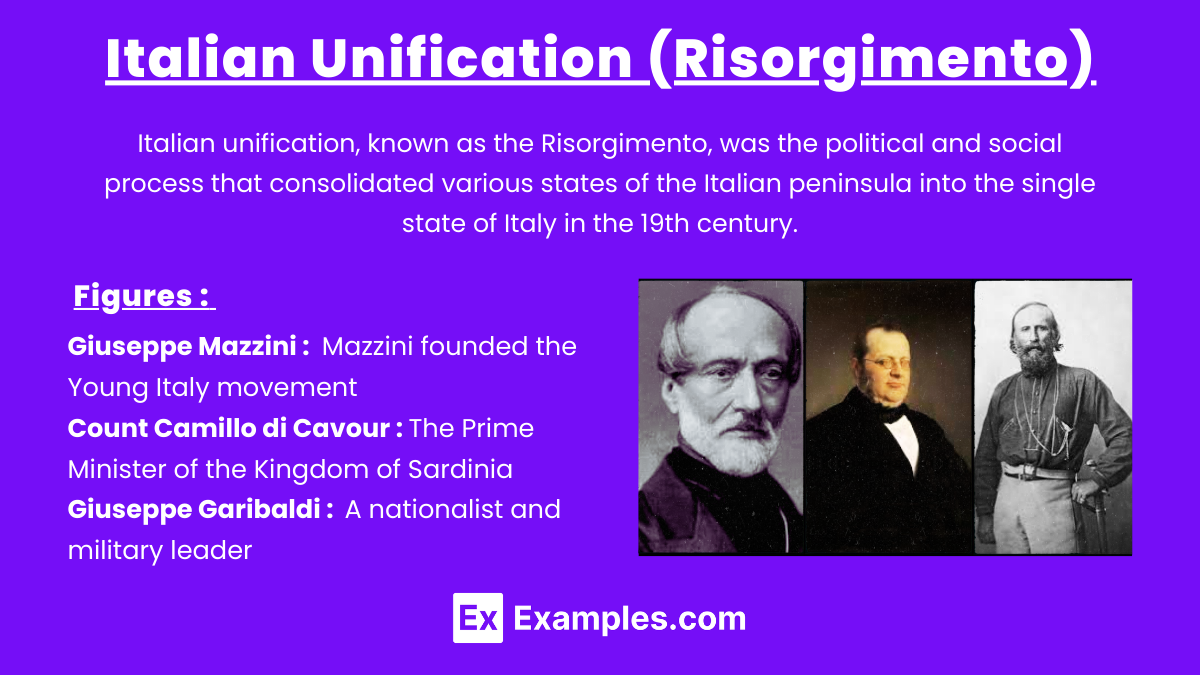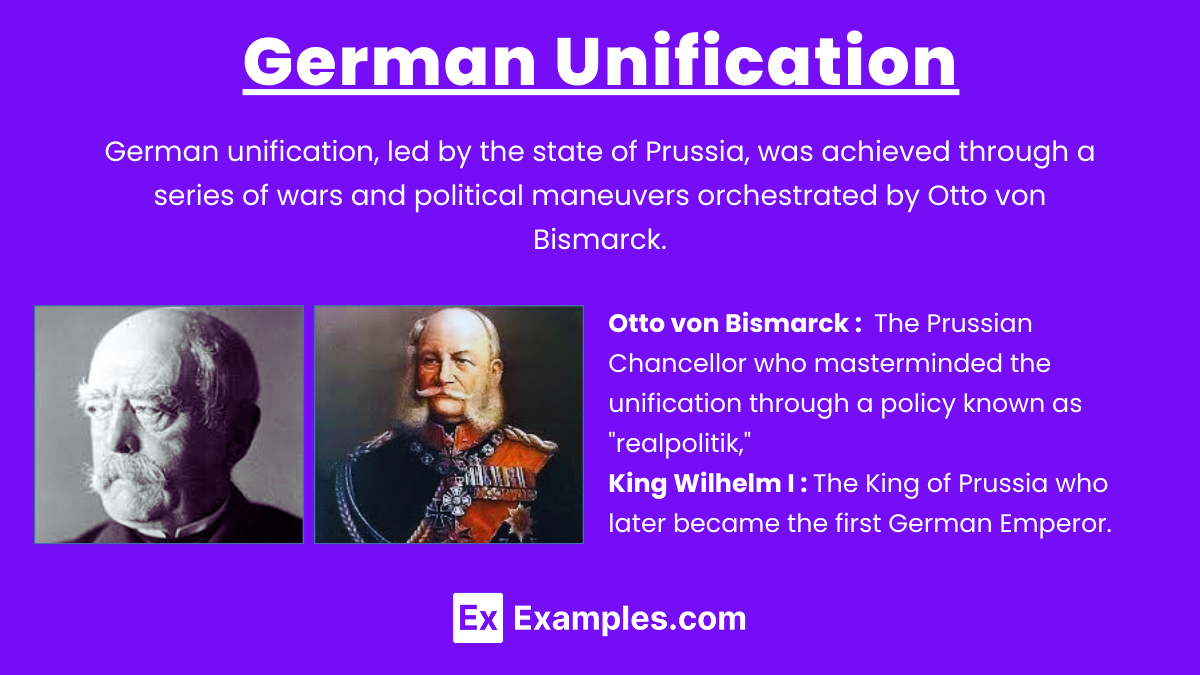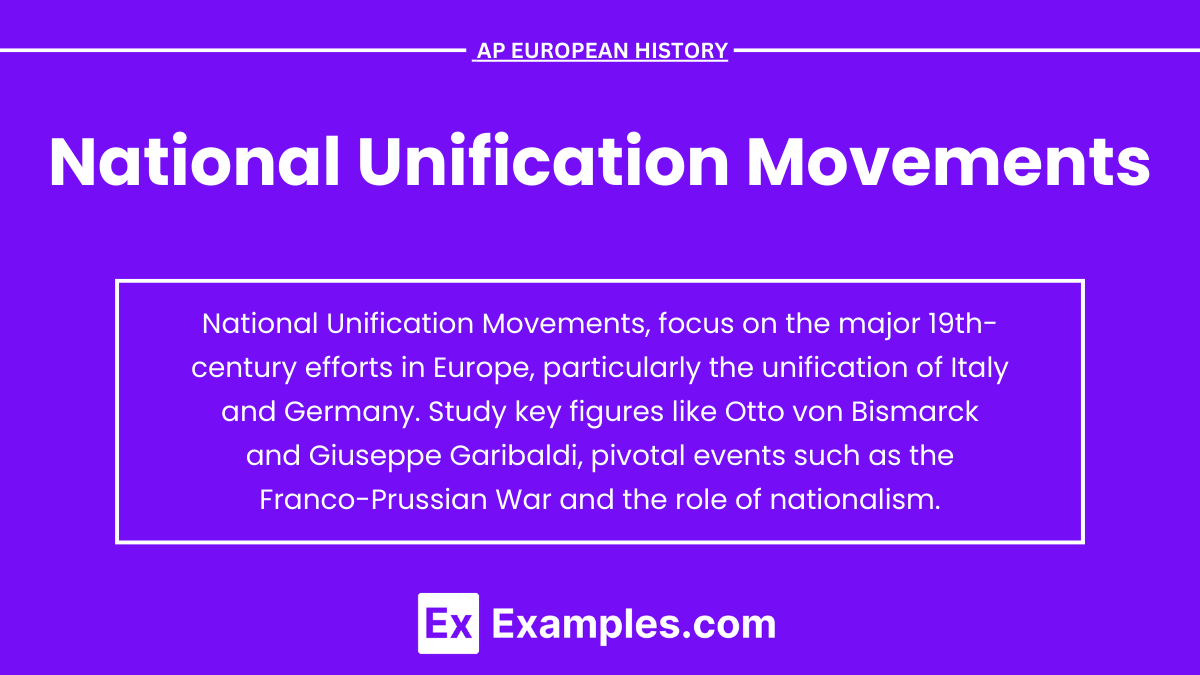In the 19th century, Europe witnessed significant national unification movements that reshaped its political landscape. Driven by rising nationalism, regions with shared cultural and linguistic identities sought to form cohesive nation-states. Key examples include the unification of Italy under leaders like Giuseppe Garibaldi and Count Camillo di Cavour, and Germany under Otto von Bismarck's leadership. These movements not only consolidated fragmented states but also influenced broader geopolitical dynamics, laying the foundation for modern European nations.
Learning Objectives
For the AP European History exam, focus on understanding the causes, key figures, events, and outcomes of the national unification movements in Italy and Germany. Learn about the roles of Giuseppe Mazzini, Count Camillo di Cavour, Giuseppe Garibaldi, and Otto von Bismarck. Study the wars that facilitated unification, such as the Austro-Prussian War and the Franco-Prussian War. Analyze the impact of nationalism and realpolitik in shaping modern European states, and understand the broader consequences for European political and social structures.
1. Italian Unification (Risorgimento)

Italian unification, known as the Risorgimento, was the political and social process that consolidated various states of the Italian peninsula into the single state of Italy in the 19th century.
Key Figures:
Giuseppe Mazzini: An early proponent of Italian nationalism, Mazzini founded the Young Italy movement, advocating for a democratic and united Italy.
Count Camillo di Cavour: The Prime Minister of the Kingdom of Sardinia, Cavour was a pragmatic statesman who used diplomacy and alliances to achieve unification.
Giuseppe Garibaldi: A nationalist and military leader, Garibaldi led the Red Shirts in the conquest of Southern Italy.
Key Events:
Revolutions of 1848: Although initially unsuccessful, these uprisings set the stage for future unification by spreading nationalist ideas.
Cavour's Diplomacy: Cavour secured French support against Austria, leading to the Second Italian War of Independence (1859-1860). The victories in this war led to the annexation of Lombardy.
Garibaldi’s Campaign: Garibaldi’s Expedition of the Thousand (1860) was crucial in conquering the Kingdom of the Two Sicilies, which eventually joined the Kingdom of Sardinia.
Unification of Italy (1861): Victor Emmanuel II was proclaimed King of Italy in 1861, though Rome and Venetia remained outside the kingdom.
Annexation of Rome (1870): The capture of Rome and the subsequent withdrawal of French troops marked the completion of Italian unification.
Challenges Post-Unification:
Regional Disparities: The north-south divide, known as the "Southern Question," highlighted economic and cultural differences.
Papal Opposition: The Catholic Church, under the Pope, initially opposed the new state, creating tensions with the Italian government.
2. German Unification

German unification, led by the state of Prussia, was achieved through a series of wars and political maneuvers orchestrated by Otto von Bismarck.
Key Figures:
Otto von Bismarck: The Prussian Chancellor who masterminded the unification through a policy known as "realpolitik," emphasizing practical over ideological goals.
King Wilhelm I: The King of Prussia who later became the first German Emperor.
Key Events:
Zollverein (Customs Union): Established in the early 19th century, this economic union of German states, excluding Austria, facilitated economic integration and laid the groundwork for political unification.
Wars of Unification:
Danish War (1864): Prussia and Austria jointly defeated Denmark, gaining control of the duchies of Schleswig and Holstein.
Austro-Prussian War (1866): Also known as the Seven Weeks' War, this conflict resulted in the decisive defeat of Austria and the exclusion of Austrian influence from German affairs.
Franco-Prussian War (1870-1871): Provoked by Bismarck, this war united the German states against a common enemy, France. The German victory led to the proclamation of the German Empire in the Hall of Mirrors at the Palace of Versailles in 1871.
Establishment of the German Empire:
Proclamation at Versailles (1871): King Wilhelm I of Prussia was crowned as the first German Emperor, marking the official unification of Germany under Prussian leadership.
Consequences and Challenges:
Kulturkampf: Bismarck's policies aimed at reducing the influence of the Catholic Church in the newly unified Germany.
Rapid Industrialization: The unification fostered economic growth, making Germany a major European power.
Impact of National Unification Movements
The unification movements in Italy and Germany reshaped the political landscape of Europe. These movements not only created new nation-states but also influenced other nationalist movements across the continent. The unification processes often involved wars, diplomatic negotiations, and internal consolidation, leading to significant political and social changes.
Key Concepts to Remember:
Nationalism: A driving force behind the unification movements, nationalism emphasized a shared identity based on language, culture, and history.
Realpolitik: A pragmatic approach to politics, focusing on practical and material factors rather than moral or ideological considerations, exemplified by Bismarck's policies.
Balance of Power: The unification of Germany and Italy altered the European balance of power, leading to new alliances and conflicts in the late 19th and early 20th centuries.
These unification movements set the stage for the political dynamics of the 20th century, including the tensions that led to World War I. Understanding these events is crucial for comprehending the broader trends in European history during this period.
Examples
Example 1
Italian Unification (Risorgimento) : The Italian Unification, known as the Risorgimento, occurred in the 19th century. It involved a series of political and military events that unified various states of the Italian Peninsula into the Kingdom of Italy. Key figures included Giuseppe Garibaldi, Count Camillo di Cavour, and King Victor Emmanuel II.
Example 2
German Unification : The unification of Germany in 1871 was led by the Kingdom of Prussia under the leadership of Otto von Bismarck. This movement consolidated numerous independent German states into a single nation-state, the German Empire, following victories in wars against Denmark, Austria, and France.
Example 3
American Civil War and Reconstruction : The American Civil War (1861-1865) was a significant period of conflict between the Northern states (the Union) and the Southern states (the Confederacy). The war's conclusion led to the reunification of the United States and the abolition of slavery, followed by the Reconstruction era, which sought to integrate the Southern states back into the Union.
Example 4
Unification of Vietnam : Vietnam's unification occurred after the Vietnam War, with the North Vietnamese government emerging victorious in 1975. The Socialist Republic of Vietnam was established, uniting North and South Vietnam under a single communist government.
Example 5
Meiji Restoration in Japan : The Meiji Restoration (1868) was a period of political revolution in Japan that restored imperial rule under Emperor Meiji. This movement effectively unified Japan under a central authority, ending the Tokugawa shogunate's feudal rule and leading to significant modernization and industrialization.
MCQ's
Question 1: What was a significant factor that contributed to the success of national unification movements in the 19th century?
a) Decline of empires and rise of nationalism
b) Expansion of colonial territories
c) Increase in international trade agreements
d) Growth of isolationist policies
Answer: a) Decline of empires and rise of nationalism
Explanation: The 19th century saw a decline in the power of large empires like the Ottoman Empire, the Austrian Empire, and the various German principalities. This decline coincided with the rise of nationalist sentiments, where people desired to form unified nation-states based on shared language, culture, and history. The movements in Italy (Risorgimento) and Germany were classic examples where the weakening of old powers allowed for the consolidation of smaller states into larger, unified nations.
Question 2: Which of the following leaders is most closely associated with the unification of Germany?
a) Giuseppe Garibaldi
b) Otto von Bismarck
c) Napoleon Bonaparte
d) Simon Bolivar
Answer: b) Otto von Bismarck
Explanation: Otto von Bismarck, the Prussian Chancellor, played a pivotal role in the unification of Germany. Through a series of wars, strategic alliances, and political maneuvers, Bismarck was able to unite the German states under Prussian leadership. His policies and the subsequent formation of the German Empire in 1871 made him a central figure in the history of national unification movements.
Question 3: The term "Risorgimento" is associated with the unification of which country?
a) Germany
b) Italy
c) Greece
d) India
Answer: b) Italy
Explanation: "Risorgimento," meaning "Resurgence" in Italian, refers to the period of Italian history from the early 19th century until 1871, during which various states on the Italian peninsula were unified into a single nation-state. Key figures in this movement included Giuseppe Garibaldi, Count Camillo di Cavour, and King Victor Emmanuel II. The movement aimed at consolidating the fragmented states into a unified Italy, achieving significant milestones such as the annexation of the Kingdom of the Two Sicilies and the capture of Rome.


